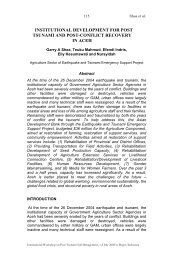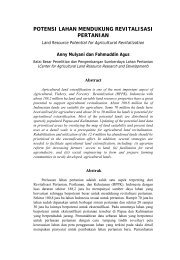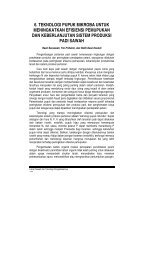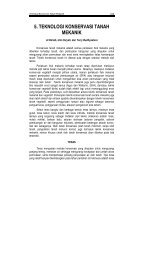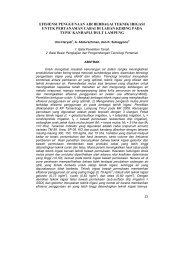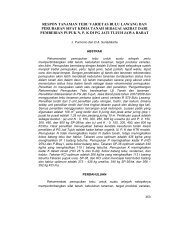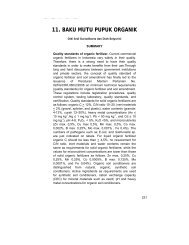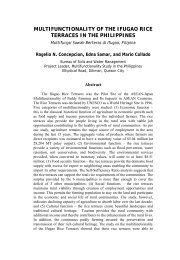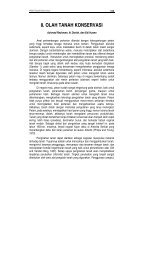Proceedings - Balai Penelitian Tanah
Proceedings - Balai Penelitian Tanah
Proceedings - Balai Penelitian Tanah
You also want an ePaper? Increase the reach of your titles
YUMPU automatically turns print PDFs into web optimized ePapers that Google loves.
66<br />
Agus F<br />
Under the natural condition, peat land is a carbon sink by forming<br />
gradually the peat dome. From a peat core in Central Kalimantan, it<br />
was found that the time range of peat formation was between 24,000<br />
to 100 years before present for the peat layers between 9 to 1 m,<br />
respectively. The peat formation ranges from a fraction to 2-3 mm<br />
thick annually and in some years the formation may be negative<br />
because of prolong droughts (Rieley et al., 2008). When peat forest is<br />
cleared and drained, the oxidized layer decompose and emit a<br />
significant amount of CO2. The method of land clearing and the<br />
successive land use and management systems determine the rate of<br />
CO2 emissions. Land use such as paddy system which requires<br />
minimal drainage, likely emit minimal below ground carbon. Oil palm<br />
plantation with average drainage depth of 60 cm could emit as high as<br />
55 t CO2 per ha annually (Hooijer et al., 2006) and this translates to<br />
the peat loss of 30 mm year -1 (orders of magnitute faster than the<br />
peat formation).<br />
Besides contributing to atmospheric CO2, peat CO2 emissions also<br />
cause subsidence because of the peat mass loss. Simultaneously,<br />
subsidence also occur because of peat compaction resulted by peat<br />
draining. The two processes of subsidence (through emissions and<br />
compaction) lead to the area susceptibility to floods and droughts<br />
because peat can retain as high as 90% of water by volume.<br />
The impacts of peat forest clearing are of local and, at the same time,<br />
global significance, because:<br />
• Global warming threatens the survival and reduce productivity<br />
of existing fauna and flora<br />
• Extreme weather conditions resulted from global warming (high<br />
intensity rains and long droughts) are problematic globally and<br />
locally<br />
• Melting of glacier, causing disappearance of small islands and<br />
flooding in the low lying coastal areas; for which Indonesia is<br />
very vulnerable.<br />
• Loss of biodiversity<br />
This paper discusses the environmental consequences in terms of (i)<br />
processes and sources of CO2 emissions as peat land forest is<br />
converted to plantation and (ii) subsidence and sustainability as peat<br />
land is converted. Implications for policy are discussed in the<br />
concluding section.<br />
PEAT LAND DISTRIBUTION AND CARBON STOCK<br />
Peat land covers an estimated 240 million hectares worldwide. Some<br />
200 million hectares are situated in the boreal and temperate regions<br />
International Workshop on Post Tsunami Soil Management, 1-2 July 2008 in Bogor, Indonesia



